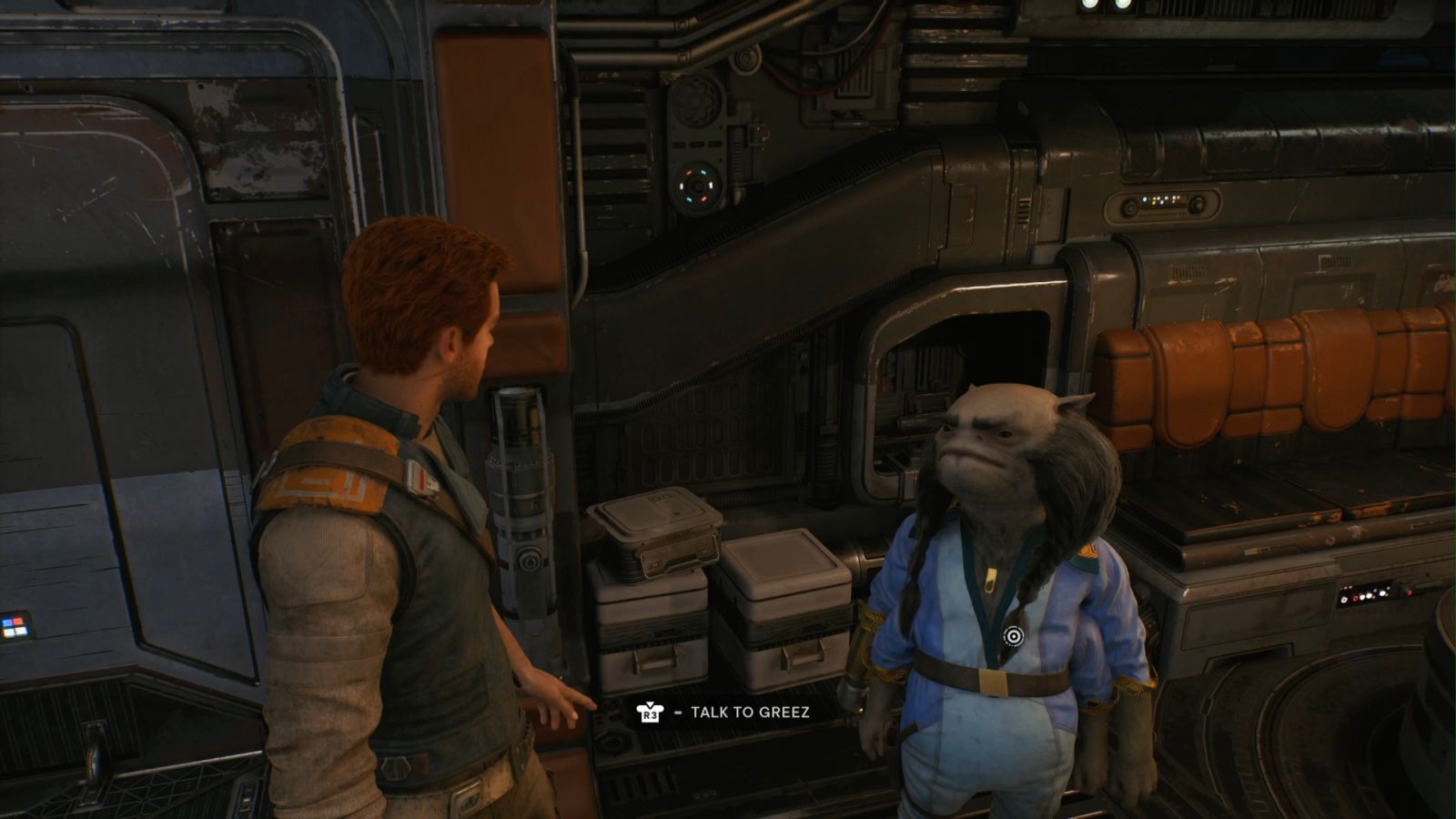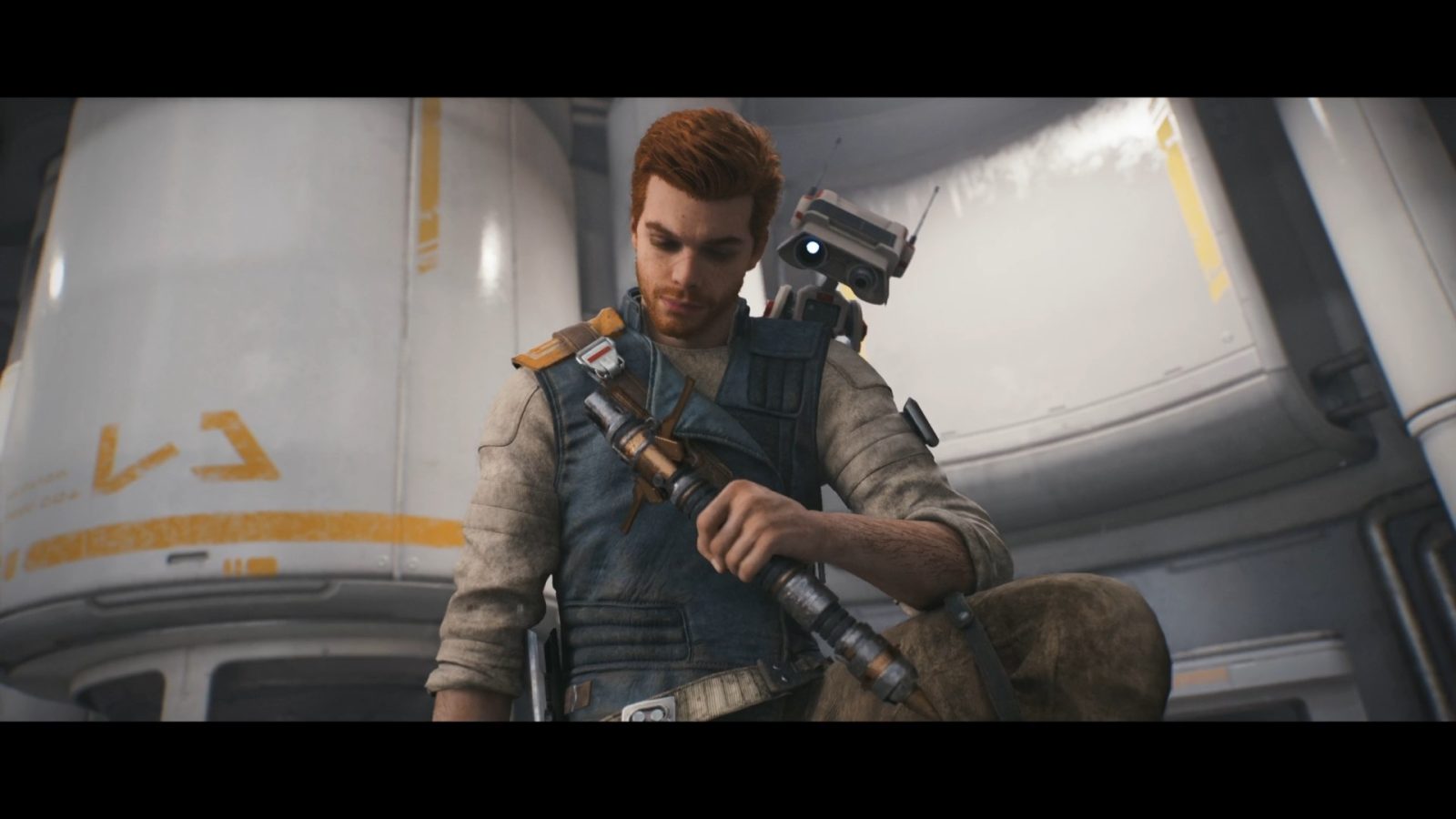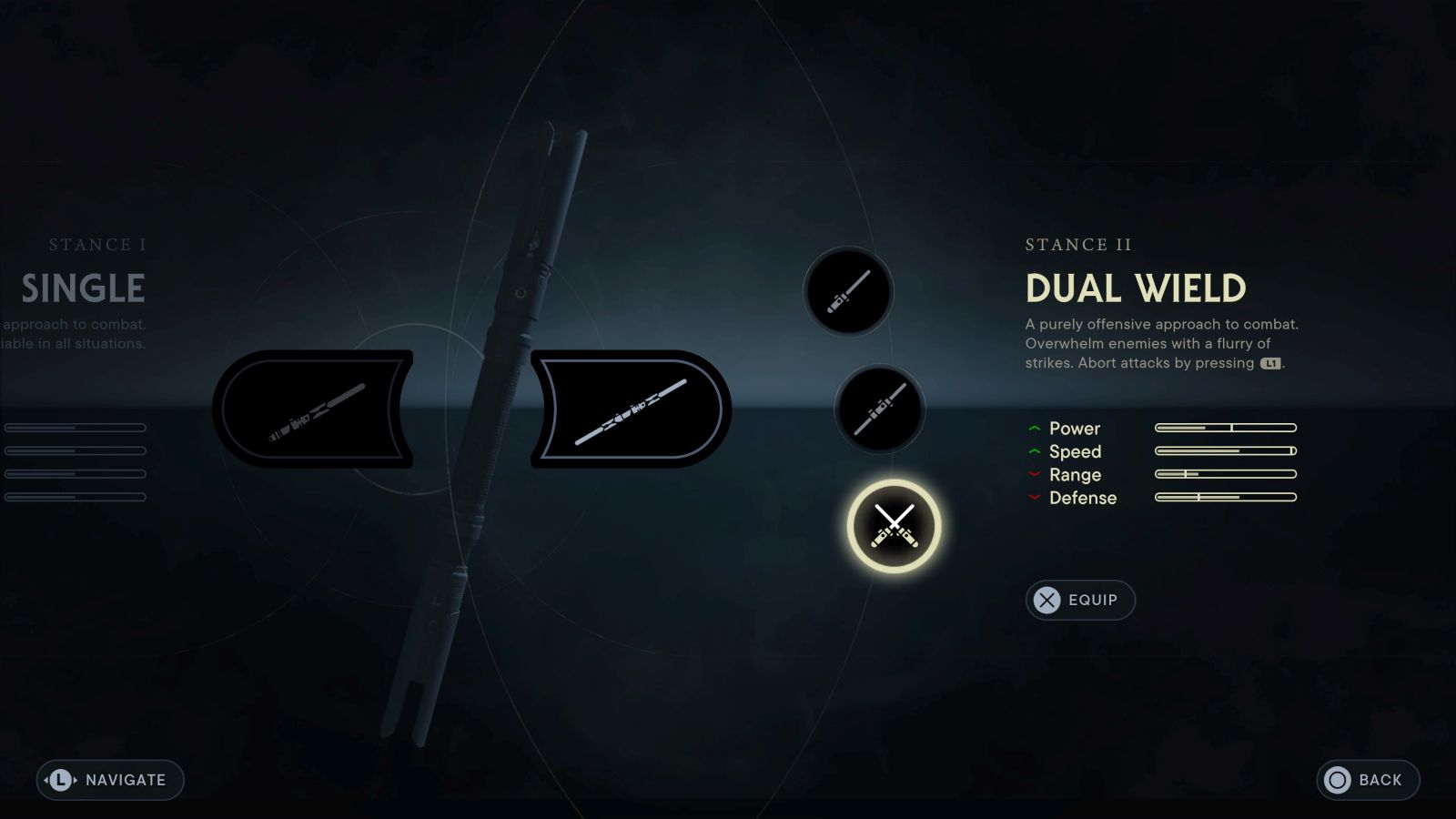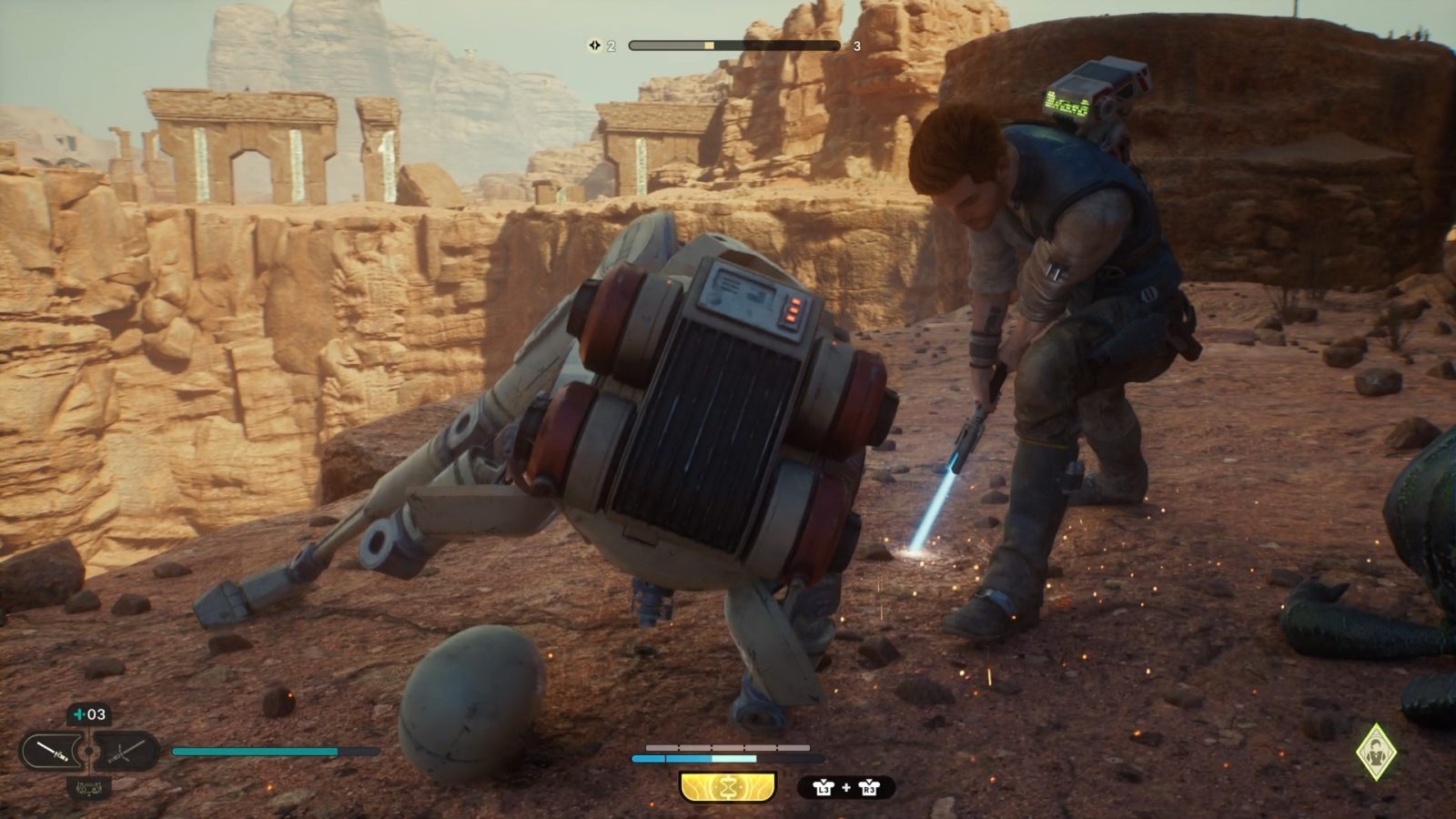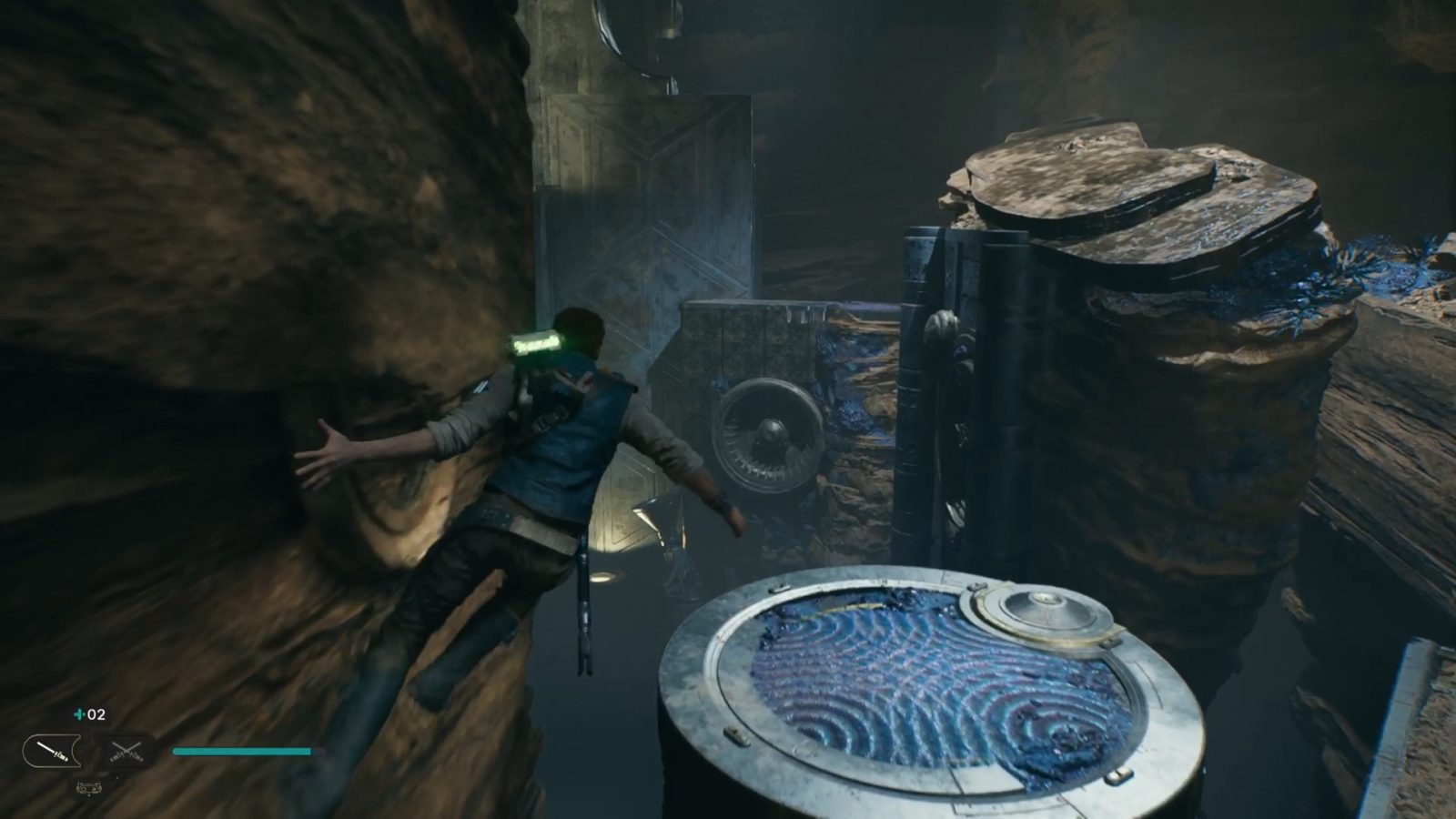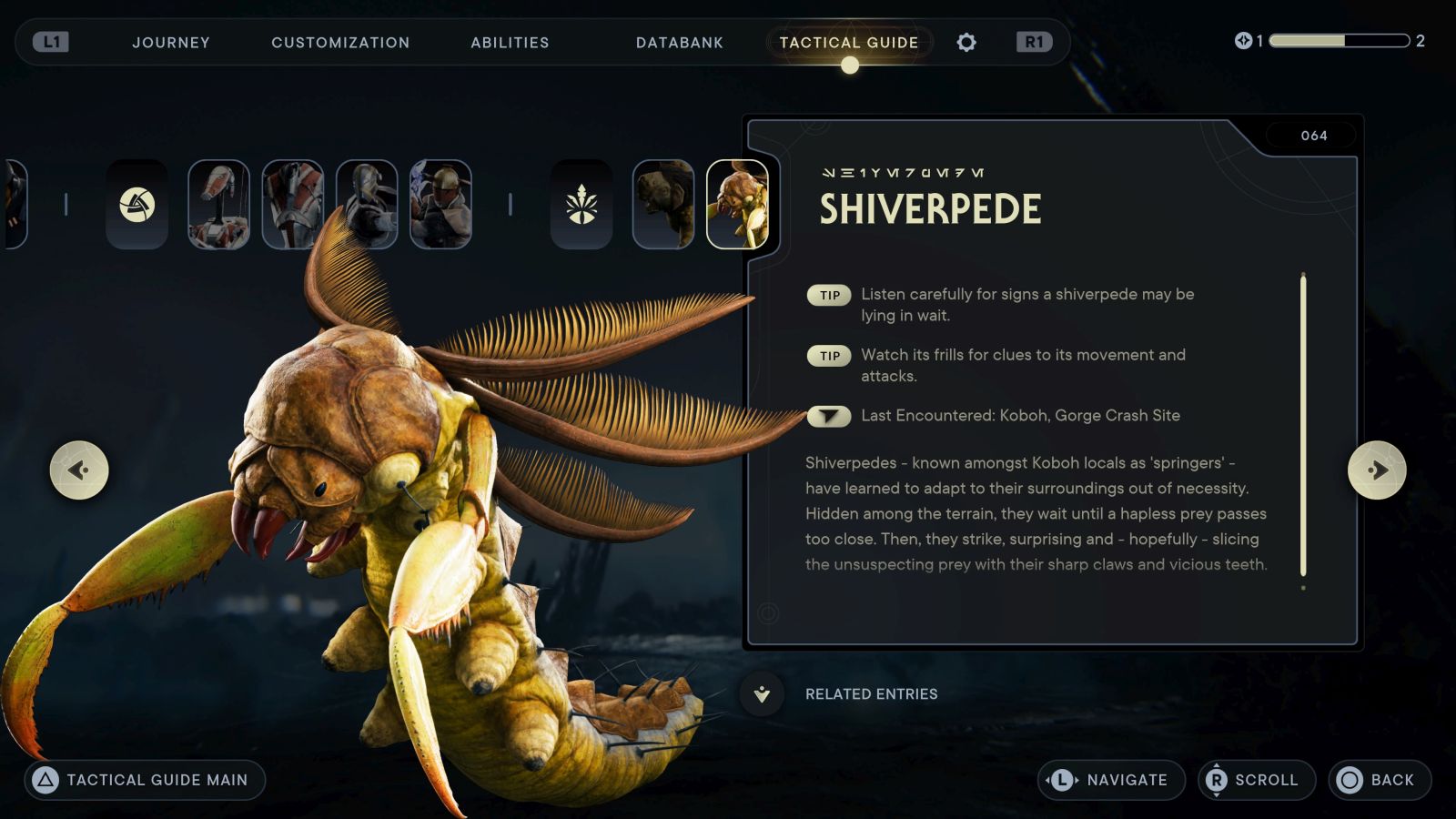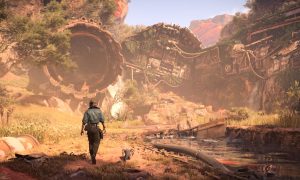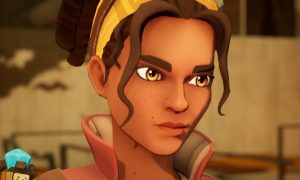As always, we steadfastly refuse to ruin the storyline of any game we review, so rest assured – you are safe to read on. Other than some initial setup, we’ll be as light a touch as possible with regards to spoilers – Star Wars Jedi: Survivor has a fantastic story, and I’d feel terrible if I somehow ruined that for you. Let’s get started.
Star Wars Jedi: Survivor opens five years after the events of Fallen Order. The team has broken up and Cal continues his fight against the Galactic Empire. Despite Cal’s best efforts, the Empire continues to grow, and things are beginning to look grim. When your heist on Coruscant goes horribly wrong, you end up high-tailing it out of there to the only place where you have a friend who might not turn you in to the Empire for a reward – Koboh. Greez has settled in there, realizing his dreams of becoming a bartender. We’ll need his help to get the Mantis back in the air. In the meantime, Koboh serves as a massive hub that you’ll return to time and again as your adventure expands across the stars. What he discovers on Koboh, however, will change not only his fate, but the very fate of the Jedi…
I’ve rewritten the paragraph above several times. I need to be vague, but the story that unfolds is fantastic. There are twists and turns, surprises, and yes as good as Fallen Order was, Jedi Survivor’s story is so much better. There are genuinely heartfelt bits, more laugh-out-loud moments than I can count, and some honest character development that feels like meeting old friends.
That isn’t to say that Cal is just going to be palling around with the old crew – far from it. The game has shifted from a mostly-linear adventure to something more akin to a semi-open world. It has more in common with God of War: Ragnarok than with its predecessor, and that’s high praise indeed. The problem with open world games is that they often lose their cinematic elements, but that’s not the case here. Jedi Survivor’s team has worked diligently to ensure that the game seamlessly moves from action to cutscene without a hitch – something that happens frequently. Similarly, you’ll find challenges and characters suddenly appear, thrusting you into a boss fight with little warning. The move to an open structure could have been a disaster, but Jedi Survivor has turned this into a strength.
I’d be remiss in my duties if I didn’t mention all the ways Star Wars Jedi: Survivor ensures absolutely everyone can play. There are a number of options, from five different difficulty levels, to literally pages of various accessibility options to choose from. If you would rather single button press rather than mash to execute a move, or if you need more loose timings, or if you just prefer to eliminate camera sway entirely, there’s an option for that. Frankly, I couldn’t think of a thing they haven’t addressed here – it’s impressive and greatly appreciated. There’s even a “story so far” for Star Wars Jedi: Fallen Order if you need a quick refresher on how you got here.
Jedi Survivor has five difficulty levels, and all of them center around a trio of stat adjustments – Parry Timing, Incoming Damage, and Enemy Aggression. Story Mode is the most loose, with parry timing being as wide as a barn door and damage being a mere inconvenience. Jedi Grand Master is no joke, flipping the tables on the story mode to make an absolutely brutal experience that only the most stalwart of Jedi should attempt.
One of my favorite things about Jedi Survivor is that it’s worth stopping and smelling the flowers, or more accurately listening to the dialogue. The various NPCs you run into, be they friend or foe, have a lot to say this time around, and some of these are downright hilarious. During one sequence, a droid is talking about how much he loves the scenery, and that he loves his easy job. He watches the cliff, he looks at the scenery, and he’s good at it. He wonders if at some point he’ll get promoted for doing such a great job, and that then he can make the other droids guard the cliff…but then he laments that he wouldn’t be able to look at the scenery anymore. “What a dilemma” he says, to which Cal remarks “Dilemma solved” having cut him in half with a quick strike from his saber. The team put a great deal of effort into these, and it shows. Every interaction feels a little more alive and it adds some real personality to the proceedings, and thankfully they are not in short supply.
The move to Unreal Engine 5 has served Jedi Survivor very well. The facial capture comes with a level of accuracy that is so immersive that I’m frankly blown away. Not just reserved for Cal, every character you meet is brought to life in a way you need to see to believe. The subtle movements in a character’s mouth, the way Greez occasionally talks a bit from the side of his face, the subtle facial expressions – the VOCAP in this game has raised the bar. That said, you will occasionally see NPCs with a vacant look on their face, or they’ll snap into full capture, look fantastic, and then snap right back to dead-eyed zombies. Smoothing out the transitions or giving them more to do than sit and wait to talk to Cal would be a good logical next step for the series.
Graphically the game has taken some massive steps forward as well. The move to current-gen has given the team the flexibility to really push the overall fidelity, which is readily apparent in every aspect of the game. The animation quality and overall polish on movement elevates the whole experience. Similarly, the fluidity of combat has improved, with many more options for direct hand-to-hand action, but also some flourishes that makes Cal feel more like a practiced Jedi. Enemies received similar treatment, with some of the Bedlam Raiders able to dodge and move, pin Cal, and otherwise make your life difficult in new and interesting ways. It makes the combat feel more visceral and captures that Cal hasn’t been sitting around doing nothing in the intervening time between adventures when he’s able to counter these attacks in equal measure.
I have to commend Respawn for managing to make a sequel where the first thing that happens isn’t immediately stripping me of my power. Cal keeps everything he’s earned in the first game and builds on it handily. Sure, your health and force powers need to be rebuilt, but no skills are lost. Cal is a Jedi Knight, and he remains a Jedi Knight at the start of this game. It’s refreshing, and I’m sure a great deal of thought and effort went into this. Thanks for putting in the time – I wish more games would tackle this power progression as cleanly.
It would have also been very easy for Respawn to simply copy and paste the saber movements from the first game, but it was immediately apparent that they did the precise opposite. Cal’s strength has grown, and while we only had two combat stances in Fallen Order, he now has a total of five to grow and discover over the course of Jedi Survivor. Cal starts with the two he ended the previous game with – single blade and double-bladed.
As before, the single blade stance is your classic Jedi all-around workhorse stance. It’s perfect for single combat, can be charged for a massive stab attack, and hits in the middle of the power curve on stamina and health damage. Switching to double-bladed lights up the saber on both ends, turning it into the most dangerous bo-staff in the galaxy. It’s excellent for crowd control, though the time necessary to wind up the whirling attack is certainly longer than either the single or dual blade attacks. This makes it a poor choice for faster enemies, but will mop up groups of droids in an instant. At higher skill tiers you’ll be able to throw it and have it circle around the area, cutting down every foe in a wide arc.
No longer relegated to a scripted finisher, dual wield stance sees Cal engage with his saber separated into two. It immediately felt more technical, focusing on timing and counters even more so than the other two stances. It is as fast as it is dangerous, unleashing a flurry of attacks with the tradeoff of leaving yourself open to attack. The tradeoff is that Cal’s attack variety and angles are also doubled. His strong attack centers himself for a moment, ready to block and counter just about any incoming attack. You can also guard cancel or dodge at the start of an attack, rather than committing to the strike – an advantage not offered by any other weapon stance.
The last two stances, Crossguard Stance and Blaster Stance, are uncovered a few hours further into the story. Thankfully, Respawn didn’t give us a stance at the very end that would end up underutilized. The Crossguard Stance utilizes a crossguard saber, not unlike the one Kylo Ren carried. It’s like wielding a broadsword, with an extended blade carried low. It’s slow to move, but when it connects it crushes everything in its path. Not unlike playing the “heavy” characters in a fighting game, this stance takes time to master. If you are the type that likes to destroy an enemy through brute force, this stance is your ally.
My favorite stance in the game is the Blaster Stance. Pairing a single saber with a blaster, Cal uses a fencing-like stance to engage with his blade. It’s not a conventional Jedi combination by any means, but it is reflective of Cal’s situation – the Empire has made him desperate, and he’s now doing whatever it takes to survive. It’s also a great stance for mixing ranges as you can fire a blaster bolt to knock an enemy off balance from their normal attack routine. Holding down Triangle will allow Cal to unleash a charged blast, causing even more damage. Your blaster bolts are not unlimited though, but instead charged by using the saber. In this way you’ll alternate between saber and gun.
You can equip two stances, and you’ll do so at any meditation point. I found myself using the paired sabers and blaster style most frequently, but every stance has a use. All of them also make use of Cal’s newest power – the ability to slow time for a short period of time. When charged, Cal will center himself, able to unleash devastation on his foes. This is a great moment to heal when the action is furious, or to wind up a slower attack to obliterate your enemies.
As in the first game, all five of these stances come with their own skill tree, which you’ll grow through points assigned when you meditate. Naturally you’ll also have a skill tree for Survival and Force Powers, making it easier than before to play the game your way. In fact, these individual paths are directly in line with the developer’s intention to allow players to try out new styles and approaches. In the first game we all ended up in the same place, but now there are reasons to specialize.
Another new power that Cal picked up in the last five years is the ability to force persuade foes. This can cause foes to act on your behalf, either defending you or attacking the enemy. This power even occasionally comes up in conversations where a decision needs to be made. These conversation moments aren’t frequent, but they are timed, so you’ll want to pay attention.
As I mentioned, you’ll meet a variety of friends on your adventures across the stars. Each of them has their own skills and abilities, and you can trigger these at will. I don’t want to ruin these, but one can pin foes in place, another will swoop in with blaster fire. I’ll leave these for you to discover as saying more would ruin it, but they change up your playstyle nicely, breaking up the normal flow of battle.
One of the challenges with Fallen Order was that all of us ended up at the same place at the end. With very little grinding you could unlock every force power, skill, powerup, and saber technique. In Jedi Survivor your powers are now split among multiple, tablet-like structures when you meditate – Survival, Lightsaber, and Force to start. These provide roughly 8 upgrades per tile, with each focused on a specific attack style or power. Using Lightsabers as an example, a power for Dual Wield allows you to reflect two bolter blasts at the same time. Another power for the dual saber style extends your attack chain by tapping X, finishing it off with a final strong attack. Finding your niche and exploiting it feels more satisfying this time around, as does lifting somebody up and then repeatedly slamming them into the ground until they stop being a problem. There isn’t a light side / dark side meter here, so feel free to turn troopers into paste.
As you earn enough XP to level up, you’ll be granted a point to spend in these disciplines. This provides a bit of player choice, allowing you to focus on a particular saber technique, upgrade path, or power, rather than just picking whatever is next on the list. It means you can play your way, emphasizing your playstyle over a more linear path. In practice, it meant I could focus on the skills I wanted to bring to the field, making Cal’s progression feel more personal. Best of all, if you are unhappy with your current loadout, or you are struggling in combat, you can simply reset all of your skills and re-allocate them. The first reset is free, but subsequent ones will cost you a skill point.
Early in Cal’s mission on Coruscant he comes into possession of an ascension cable. This is the key to one of Survivor’s biggest innovations – verticality. There are a number of truly challenging platforming sections that’ll push your timing to the limit. As before, a fatal fall merely costs you a little bit of life, resetting you back to the start of the sequence, so the game doesn’t overly punish you for missing a beat. A full death still puts you back at a meditation point, but even that isn’t that tough of a thing. As before, when you are eventually defeated, the creature that defeated you will absorb all of your lost XP. Defeating that creature will restore that XP to you, as well as refilling your life and force to maximum as a reward for enacting your payback. This becomes increasingly helpful when the creature you are facing is capable of picking you up in a single swipe and putting you in its mouth, ending your adventure in a single crunch.
As this is several years after the first game, we’ve moved past the traditional troopers and into the “Roger Roger” age of Battle Droids. That means tangling with enemies like the IG-100 Magna Guard Droid, complete with Elecrostaff (these are the guys who defended General Grievous on his capital ship in the movies), the aforementioned B1 Battle Droids who fall by the thousands against Gungans (of all things), Droidekas (the roller droids with shields), BX Droids (super-agile vibrosword droids that were purpose built to tangle with Jedi) and the B2 Super Battle Droid (the beefier droids that look like they hit the gym), just to name a few. Here’s the funny thing – you shouldn’t kill these guys. Or not at first, at least. The banter between them is often hilarious, and well worth a moment’s pause. The DT Sentry Droid (you may remember these guys from Star Wars Rebels or The Bad Batch) on the other hand has nothing funny to say. In fact, these killing machines are going to be one of the most formidable Droid foes you’ll face, sporting three different loadout configurations that all have to be countered in different ways. KX Security Droids have more of a dry wit as they pummel you to death with their stun batons. You’ll still encounter plenty of human foes in Jedi Survivor, and often far tougher ones than you’ve seen before. If you felt there wasn’t enough variety in Fallen Order, there’s more than plenty of it now.
Koboh is a semi-open world, and both Cal and BD have a few new skills to help them explore it. BD-1 can now be used as BD-Noculars, allowing Cal to look into the distance and mark areas for exploration on his minimap. The entire minimap system has been greatly improved, now marking clearly where you’ve been, what paths remain to be opened, what paths are blocked, and much more. If you enable it, it’ll even point out where you should go next to push the main storyline. Rather than just putting a Jedi Order symbol on the final destination, it’ll also put a symbol on the next step in your path. To help you with that backtracking, you are also now able to fast travel to any other meditation point you’ve uncovered. This is a huge time saver when you need to go back for a collectible or to hit your next mission. Everywhere you look in Jedi Survivor you’ll find a way where Respawn has given players whatever they need to be able to enjoy the game, regardless of skill level or challenge, and all without lowering the difficulty for players who want it.
You’ll be returning to Koboh periodically as it serves as a central hub in the game. Greez’s cantina is called Pyloon Saloon, and the folks you meet throughout the game will often pop in here for a drink and a chat. When you first arrive it’s a bit run down. As you put the work in and help the folks of Koboh with their various needs and wants you’ll find them visiting as well. The added revenue from all the traffic will allow Greeze and Monk, the robo-bartender who minds the place, to expand the place. You’ll find new shops, a rooftop garden, and much more as your network of allies grows.
There was a real highlight for my wife and I, and she almost lept out of her seat when she heard it. One of her favorite bands, a Mongolian band named The Hu, sings one of her favorite tracks. Made specifically for the game, you’ll hear their track called Sugaan Essena. And now I’m happy to share it with all of you!
Jedi Survivor has a great deal more customization than its predecessor. Cal’s baby face has been replaced with a few scars, a bit of a beard, and a much better haircut. It’s clear the team put a great deal of effort into making his hair look realistic with a bit of movement. It’s odd to be spending this much time talking about Cal’s hair, but Respawn did as well. In fact, he has 14 hair styles, 13 beards, 19 jackets, 10 shirts, 10 pants, plus all of the material changes to be found and applied – it’s good to see the man outgrow his unhealthy poncho obsession. You’ll be able to adjust the look of your saber, BD-1’s parts, his blaster, his clothes, and more, including the material, overall condition, and individual pieces.
While they were tuning up the customization and combat, Respawn also revamped the entire movement systems in the game. Cal moves like a man who has spent the last five years training as a Jedi Knight, and the result is smoother movement across the board. No longer do you have to hit a button to grip on climbable surfaces, and Cal now more easily traverses the environment. Cal will slide down surfaces in a way that reminds me of the knife slide in classic Prince of Persia, he does the wall to wall bounce straight out of Ninja Gaiden, there’s a heavy Titanfall influence across the board, and all for the better. While it’s only been a few years since the first game, it’s clear that Respawn has been working hard on the overall quality of the animations in the game, from top to bottom.
Outside of the main mission you’ll also be tasked directly with side quests, or you can also hear rumors of potential quests. These are marked on your map when you receive them, allowing you to tackle these if you wish, often leading to skill points, meditation cairns to earn skill points, and obviously XP. These side quests encourage you to explore the worlds as you’ll find the best rewards and challenges off the beaten path.
As you explore you’ll uncover Meditation Chambers that have been in place for hundreds of years. Cal can use his Psychometry (his ability to infer knowledge from objects he touches using the force) to learn about those Jedi who came to test themselves in this place in the past, and what they learned or encountered along the way. These can help Cal solve the puzzles, as well as revealing more of the story of these ancient spaces. The rewards for solving these optional Meditation Chambers are far better than a cosmetic or a new poncho – you’ll be introduced to a new upgrade called “Perks”. These remind me of the Shrines in Breath of the Wild – they are entirely optional, but each one is worth exploring.
Speaking of optional challenges, you’ll occasionally find fractures in the force. These optional challenges very much live up to their name. Cal will meditate at these spots and attempt to close the fracture by completing challenges. Some of them are platforming, some ask you to use your force powers or specific saber techniques. All of them are going to push your skills to the absolute limits, but you’ll be rewarded if you clear them.
There are a total of 25 perks in Jedi Survivor, and they are scattered everywhere. Sometimes awarded for completing specific tasks, and other times purchased by trading in collectable items found in the environment, these perks can provide a definitive tweak to your playstyle. Some extend your block window, others make that block charge faster. Some will provide you with additional XP for beating foes in combat, while still others can give you additional attack power at the expense of guard power or speed. Each of these perks take a number of slots, and you’ll only have three slots to start with, though you’ll be able to unlock more as you progress. With such a large pool and limited slots, you’ll have to be picky about how many of them you enable at any given time.
One of the complaints in Fallen Order was that, while droids could be ripped to pieces, humanoids remained stubbornly intact. Well, fret no longer and let the limbs fly – your lightsaber is no longer a stun stick, removing arms and legs aplomb. While you aren’t going to Darth Maul any humanoids in half, you also won’t feel like you’ve got a broken sword any longer.
If you made your way through a portion of Fallen Order and decided to jump back in only to find yourself a little lost, you’ll be happy to find a new training mode at any meditation point. This will allow you to reacclimate yourself if you are returning to the game, or as a way to brush up on a technique that maybe isn’t immediately clear to you.
I’d like to take a moment and thank whoever designed the Shiverpede. These nasty hook-armed giant slug monsters managed to ambush me almost every time I encountered them. The Unreal Engine 5 foliage does a magnificent job at camouflaging these nasty little creatures, and they took a bite out of me more times than I can count – bravo, you monster.
I’ve played Jedi Survivor on both PC and PlayStation 5, and both of them have a few nagging issues that should be ironed out either at launch or shortly thereafter. The PlayStation 5 suffers from some framerate hiccups when the environment is too hectic or filled with active mist/waterfalls. You’ll occasionally see flickering of lighting at the seams or the odd texture pop-in. I’ve seen a handful of strange Havok issues where enemies you just cut in half continue to wiggle. None of these are a surprise as they seem to plague every game at launch nowadays. On PC I have had the odd graphical hiccup, though these are far less frequent. The PC’s textures and lighting are a MASSIVE step up from their console counterparts. While the PS5 (and I have no doubt the Xbox Series X version – I make no promises for the S model) look fantastic, the PC is head and shoulders the better looking of the choices. That said, there are still some lighting issues there as well. Day 1 drivers and Day 1 patches usually deliver remedies for these issues, but it’s the first post-launch patch that’ll really shore things up. Don’t get me wrong – you aren’t going to have a bad experience here, you just might notice a hiccup or two. It’s not going to ruin your adventure by any meaningful measure.
The PS5 controller does some heavy lifting in Jedi Survivor, offering a chirp when BD-1 finds something to scan, and letting you feel the lightest of taps as Cal runs across the terrain. Similarly, the sound of administering a stim comes from that same speaker, raising the immersion level nicely. The impact of your saber, the thunk of the blaster, and the crash of a saber stalemate is something you’ll feel, and I’m here for it.
On nearly every planet you visit, and in several instances on Koboh, you’ll meet various folks who will gladly help you out – for a price. Some want you to collect various bits of rare rock, others prefer that you crush bounties. They all offer a variety of cosmetic items, and a few extra goodies like music tracks and new perks on occasion as well. In the case of bounties, you’ll be able to unlock a list of targets that immediately resembled Assassin’s Creed’s more recent entries, offering up standard targets as well as legendary bounty hunts for even greater rewards. 16 in all, you’ll have to track these targets down and defeat them on your own.
If you’ve not picked up on it after literally over four thousand words on the subject – Star Wars Jedi: Survivor is absolutely massive, and with a great many interconnected systems. The main story will take roughly 25 hours to complete, but there’s no way I can see somebody running that narrow path. There is so much to see and experience, and all of it feels like main story content around every corner. The world feels lived in, and the cinematic nature shines through, making me want to help every person, find every item, and uncover every secret. Respawn has done the impossible, making an already magnificent game even better in its sequel. Star Wars Jedi: Survivor is an early contender for game of the year. It’s rare for a game to snare me this way, but Star Wars Jedi: Survivor outshines the already-phenomenal Fallen Order in every single way.
Ron Burke is the Editor in Chief for Gaming Trend. Currently living in Fort Worth, Texas, Ron is an old-school gamer who enjoys CRPGs, action/adventure, platformers, music games, and has recently gotten into tabletop gaming.
Ron is also a fourth degree black belt, with a Master's rank in Matsumura Seito Shōrin-ryū, Moo Duk Kwan Tang Soo Do, Universal Tang Soo Do Alliance, and International Tang Soo Do Federation. He also holds ranks in several other styles in his search to be a well-rounded fighter.
Ron has been married to Gaming Trend Editor, Laura Burke, for 28 years. They have three dogs - Pazuzu (Irish Terrier), Atë, and Calliope (both Australian Kelpie/Pit Bull mixes), and an Axolotl named Dagon!

Star Wars Jedi: Survivor improves on its predecessor in every way, giving us not only more of what we loved, but doing so in a massive cinematic interconnected universe full of brand new engaging features. This is your early contender for game of the year.
PROS
- Open world doesn’t detract from the cinematic experience
- Graphics, animations, and engine improvements across the board
- Excellent story with memorable characters old and new
- Options to play your way around every corner
- Too many more to list…
CONS
- Occasional graphical oddities on PC and PS5
See below for our list of partners and affiliates:


